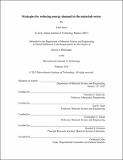| dc.contributor.advisor | Timothy G. Gutowski. | en_US |
| dc.contributor.author | Sahni, Sahil | en_US |
| dc.contributor.other | Massachusetts Institute of Technology. Department of Materials Science and Engineering. | en_US |
| dc.date.accessioned | 2013-11-18T17:36:51Z | |
| dc.date.available | 2013-11-18T17:36:51Z | |
| dc.date.copyright | 2013 | en_US |
| dc.date.issued | 2013 | en_US |
| dc.identifier.uri | http://hdl.handle.net/1721.1/82182 | |
| dc.description | Thesis (Ph. D.)--Massachusetts Institute of Technology, Dept. of Materials Science and Engineering, 2013. | en_US |
| dc.description | This electronic version was submitted by the student author. The certified thesis is available in the Institute Archives and Special Collections. | en_US |
| dc.description | Cataloged from student-submitted PDF version of thesis. | en_US |
| dc.description | Includes bibliographical references (p. 155-175). | en_US |
| dc.description.abstract | This research answers a key question - can the materials sector reduce its energy demand by 50% by 2050? Five primary materials of steel, cement, aluminum, paper, and plastic, contribute to 50% or more of the final energy use and CO₂ emissions by industry, and thus are of primary focus. Both technical and demand-side strategies are evaluated to conclude that halving energy demand by 2050 is unlikely given the limitations governed by thermodynamics, scrap availability, and producer/consumer preferences, however some of the strategies analyzed offer encouraging opportunities and should be pursued. The thesis starts with understanding the evolution of material demand as society transforms from a developing to a developed economy. Economic scopes of global, USA, China, and India are assessed. The evolution trends are starkly different. The US shows strong signs of saturation while; both developing economies of China and India do not. The actors of material demand are analyzed to determine what is driving the difference. Results show that consumer income and population have been consistently increasing, but in the second half of the 20th century, the US industry has demanded less material per dollar output, while the US industry output has continued to grow. Collectively they tend to cancel each other, presenting a material saturation phenomenon. For China and India not only is the industry income and industry share of GDP growing, for each unit value addition, industry has continued to demand more material, avoiding demand saturation. One major way to reduce energy used for materials is to decrease the energy intensity of material production. Four technology based strategies are investigated without regard to cost: 1) widespread application of best available technology (BAT), 2) BAT to cutting edge technologies, 3) aggressive recycling, and finally, 4) significant improvements in recycling technologies. Taken together these aggressive strategies could produce impressive gains, on the order of a 20% reduction in energy relative to 2005, but well short of the goal of 50% reduction. Ultimately, we face fundamental thermodynamic and scrap availability constraints. Thus reducing material demand without compromising any service (called "material efficiency") is outlined as an approach to solving this dilemma. One way to increase material efficiency is use products for longer. Remanufacturing can support this by bringing used products back to like-new condition. Remanufactured products that substitute for new products are claimed to save energy. This comes from only looking at the materials production and manufacturing phases of the life cycle. However, when the use phase is included, the situation can change radically. For the 25 product cases we analyzed, 8 cases clearly saved energy, 6 did not, and 11 were too close to call. The drivers for this difference are explained. Thus the energy saving potential of remanufacturing seems complex and uncertain, especially given the trend of powering up of products followed by improvement of their energy efficiencies. As a result focusing remanufacturing efforts on passive products is recommended. Thus scalable material efficiency strategies need to be discovered. However even with the optimistic energy efficiency strategies deployed, in order to achieve the targets, demand increase for the materials needs to be restricted to under 25% of 2005 quantities. This entails that by 2050 we would need to reduce global demand per capita by 10% of today's global average and by 70% of today's US average which is an insurmountable task. Material efficiency strategies hold an impressive technical potential but face severe economic and behavioral challenges that future research needs to overcome. | en_US |
| dc.description.statementofresponsibility | by Sahil Sahni. | en_US |
| dc.format.extent | 185 p. | en_US |
| dc.language.iso | eng | en_US |
| dc.publisher | Massachusetts Institute of Technology | en_US |
| dc.rights | M.I.T. theses are protected by
copyright. They may be viewed from this source for any purpose, but
reproduction or distribution in any format is prohibited without written
permission. See provided URL for inquiries about permission. | en_US |
| dc.rights.uri | http://dspace.mit.edu/handle/1721.1/7582 | en_US |
| dc.subject | Materials Science and Engineering. | en_US |
| dc.title | Strategies for reducing energy demand in the materials sector | en_US |
| dc.type | Thesis | en_US |
| dc.description.degree | Ph.D. | en_US |
| dc.contributor.department | Massachusetts Institute of Technology. Department of Materials Science and Engineering | |
| dc.identifier.oclc | 862073638 | en_US |
